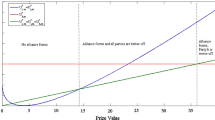Abstract
We study a bargaining game between an individual and an ‘alliance’ in the sense of Manzini and Mariotti (J Econ Theory 121:128–41, 2005), in which the opponent of the alliance is incompletely informed about the relative strengths of its members. The best equilibrium outcome for the alliance under a unanimity rule is not attainable with a non-unanimity rule. However, unlike in the complete information model, less than optimal outcomes and delays may occur with positive probability even under unanimity, depending on the prior beliefs and the preferences of the agents.
Similar content being viewed by others
References
Barberá S, Jackson MO (2004) Choosing how to choose: self-stable majority rules and constitution. Q J Econ 119: 1011–1048
Maggi G, Morelli M (2006) Self-enforcing voting in international organizations. Am Econ Rev 96: 1137–1158
Manzini P, Mariotti M (2005) Alliances and negotiation. J Econ Theory 121: 128–141
Rubinstein A (1982) Perfect equilibrium in a bargaining model. Econometrica 50: 97–110
Author information
Authors and Affiliations
Corresponding author
Additional information
We are grateful to a careful referee for comments. We wish to thank Clara Ponsati for useful comments.
Rights and permissions
About this article
Cite this article
Manzini, P., Mariotti, M. Alliances and negotiations: an incomplete information example. Rev Econ Design 13, 195–203 (2009). https://doi.org/10.1007/s10058-008-0053-8
Published:
Issue Date:
DOI: https://doi.org/10.1007/s10058-008-0053-8




